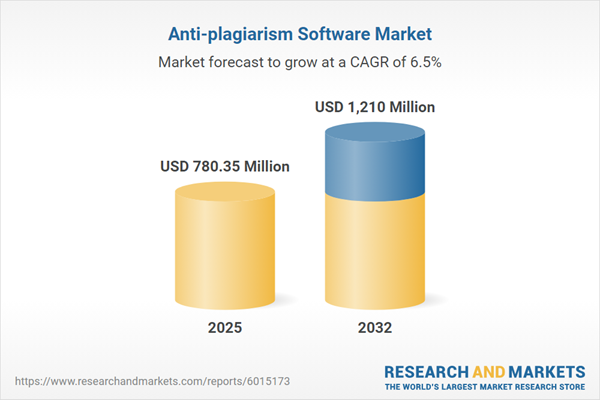Speak directly to the analyst to clarify any post sales queries you may have.
As organizations focus on content authenticity and regulatory alignment, the anti-plagiarism software market has become central to risk management strategies. Solutions now address demands for secure, compliant, and scalable content verification, helping enterprises and public sector leaders ensure business continuity and operational trust.
Market Snapshot: Anti-Plagiarism Software
In 2024, the anti-plagiarism software market reached USD 733.32 million and is projected to see strong growth, with expectations of USD 780.35 million in 2025 and potential surpassing USD 1.21 billion by 2032. The compound annual growth rate stands at 6.46%. This momentum is propelled by intensified regulatory requirements, advancing digital transformation, and prioritization of intellectual property. Influential drivers include automation needs, technology innovations in content checking, and expanding digital networks. Enterprises and education providers are deploying these capabilities to keep pace with dynamic digital workflows and evolving compliance landscapes.
Scope & Segmentation
This in-depth report equips executives and compliance professionals with actionable insights vital for product planning, technology leadership, and regional growth. Key focus areas include:
- End Users: Corporations protecting intellectual property, education authorities from K-12 through higher education, government agencies enforcing compliance, and publishers seeking originality in submissions.
- Deployment Modes: Cloud, on-premise, and hybrid systems foster operational flexibility, data locality, and regulatory adherence across markets.
- Detection Types: Audio, code, image, and text matching capabilities address the spectrum of content duplication, paraphrase detection, and plagiarism across digital formats.
- Offerings: Standalone software options and robust managed services are available to support diverse organizational processes and anticipated demand.
- Organization Sizes: Solutions scale from small businesses to large enterprises, enabling tailored verification approaches and supporting compliance at every operational tier.
- Geography: Adoption remains strong in the Americas, EMEA, and Asia-Pacific, with leading markets including the United States, United Kingdom, Germany, India, China, and Australia. Local regulatory trends and digital infrastructure investments influence adoption patterns.
- Key Companies: Top vendors are iParadigms LLC, Grammarly Inc., Ouriginal Holding B.V., PlagScan GmbH, Crossref Inc., Unicheck LLC, Indigo Stream Technologies LLC, PlagiarismCheck.org LLC, Quetext LLC, and Scribbr B.V.
Key Takeaways
- Anticipated increases in content creation across industries are making intellectual property protection a priority for compliance-focused organizations.
- Artificial intelligence and machine learning integration enable more sophisticated identification of paraphrased or subtly replicated materials, supporting thorough vetting across media types.
- Flexible deployment frameworks, especially cloud and hybrid, serve distributed enterprises and education systems, helping teams manage cross-border and multilingual content verification alongside regulatory shifts.
- Accrediting bodies and regulatory authorities are influencing investment choices by emphasizing automated compliance and evolving operational standards, supporting future-ready governance models.
- Suppliers differentiate offerings by integrating with digital platforms and tailoring support packages, fostering efficient alignment with sector-specific needs and long-term operational goals.
- Strategic collaborations in technology and compliance position enterprises to adapt swiftly as content control standards, partnership models, and data protection policies evolve regionally and globally.
Tariff Impact
Recent changes in U.S. tariffs have contributed to higher costs for deploying anti-plagiarism software, particularly in server infrastructure and licensing. Providers are addressing cost pressures with local data centers, revised pricing, and extended contract terms. This approach supports improved budget control and investment planning amid uncertain regulatory conditions.
Methodology & Data Sources
This analysis relies on primary interviews with industry stakeholders, comprehensive market surveys, and secondary research from trusted sources. Subject-matter experts validate adoption patterns, market trends, and the accuracy of competitive positioning in the anti-plagiarism software sector.
Why This Report Matters: Anti-Plagiarism Software Market
- Supports procurement and compliance leaders with a thorough view of the anti-plagiarism software market, aiding in informed strategic and operational planning in business, education, and government environments.
- Explains key technology trends, regulatory factors, and best-fit deployment options to enable proactive risk mitigation and improve overall compliance with evolving standards.
- Assists with supplier and partnership decisions, helping to manage operational expenses and optimize collaboration, especially as cost pressures and data protection needs change.
Conclusion
Using this report, decision-makers can strengthen content assurance and compliance programs, support ongoing digital initiatives, and foster greater resilience as industry standards and technology continue to develop.
Additional Product Information:
- Purchase of this report includes 1 year online access with quarterly updates.
- This report can be updated on request. Please contact our Customer Experience team using the Ask a Question widget on our website.
Table of Contents
3. Executive Summary
4. Market Overview
7. Cumulative Impact of Artificial Intelligence 2025
Companies Mentioned
The companies profiled in this Anti-plagiarism Software market report include:- iParadigms, LLC
- Grammarly Inc.
- Ouriginal Holding B.V.
- PlagScan GmbH
- Crossref, Inc.
- Unicheck LLC
- Indigo Stream Technologies, LLC
- PlagiarismCheck.org LLC
- Quetext LLC
- Scribbr B.V.
Table Information
| Report Attribute | Details |
|---|---|
| No. of Pages | 181 |
| Published | October 2025 |
| Forecast Period | 2025 - 2032 |
| Estimated Market Value ( USD | $ 780.35 Million |
| Forecasted Market Value ( USD | $ 1210 Million |
| Compound Annual Growth Rate | 6.4% |
| Regions Covered | Global |
| No. of Companies Mentioned | 11 |









